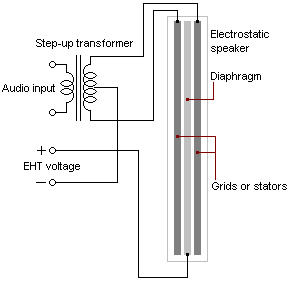What are drivers
To keep it really simple, a driver is a thing that ‘drives’ the air. The movement that the driver makes creates pressure waves, resulting in sound. The driver is the core of any loudspeaker of headphones, and it produces the sound you hear. Drivers exist in many types and sizes, from the smallest IEM’s to huge subwoofer drivers.
Dynamic drivers

Dynamic drivers are the most commonly found drivers, found in most headphones from budget to high-end. In this case, the word dynamic has nothing in common with the term ‘dynamic range’ but it has all to do with the dynamic transducers they use. Dynamic transducers convert analog audio signals into sound waves.
So how do they really work?
Electromagnetic induction is the production of voltage across an electrical conductor in a changing magnetic field. This can be used to explain what is happing in drivers, a varying voltage in a conductor will cause an effect in a magnetic field. When dealing with permanent magnets and conductive material, electromagnetic induction will cause relative movement between the two components in an attempt to maintain equilibrium.
In the case of a dynamic driver, the conductive coil has an AC voltage, or in other words an audio signal. This changing voltage in the conductor wants to cause a change in the magnetic field making the conductor move.
So as the audio signal passes through the coil, the permanent magnetic field that surrounds it causes it to move up and down within the available space. This movement causes the diaphragm to push and pull air around the driver creating sound waves that represent the audio signal.
Planar magnetic drivers
Planar magnetic drivers also convert energy based on the principle of electromagnetic induction. However, the conductive part is directly incorporated in the diaphragm. In a way, a planar works the same as a dynamic driver, but the diaphragm is placed between two closely spaced slotted discs. those discs are made of magnets, and the diaphragm between it is made out of a thin film with a flattened conductive wire. This flat thin diaphragm holds the name planar magnetic since the magnets work in a plane.

So the audio signal passes through the conductive wire, an alternating magnetic field is produced which causes the diaphragm as a whole to vibrate between the two magnetic discs. Due to the nature of the design, the magnets must be either stronger, heavier, or both compared to those used in moving-coil designs. Since the entire film moves planar’s are often described as “quick” and “fast” sounding.
Electrostatic drivers
Electrostatic drivers work completely differently than normal dynamic or planar drivers. They work by applying a static electrical charge to a thin film that floats between two perforated metal plates. When an audio signal is applied to these plates the entire membrane moves back and forth due to the electrical attraction and repulsion.

Headphones that use electrostatic drivers are much more expensive than dynamic drivers and require a specialized amplifier to run.